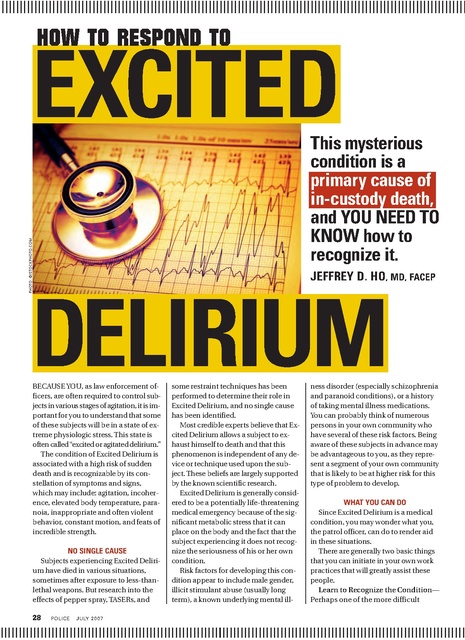Taser Police Mag How to Respond to Excited Delirium 2007
Download original document:

Document text

Document text
This text is machine-read, and may contain errors. Check the original document to verify accuracy.
HOW TO RESPOND TO EXCITED PHOTO: ©ISTOCKPHOTO.COM This mysterious condition is a primary cause of in-custody death, and YOU NEED TO KNOW how to recognize it. JEFFREY D. HO, MD, FACEP DELIRIUM BECAUSE YOU, as law enforcement officers, are often required to control subjects in various stages of agitation, it is important for you to understand that some of these subjects will be in a state of extreme physiologic stress. This state is often called “excited or agitated delirium.” The condition of Excited Delirium is associated with a high risk of sudden death and is recognizable by its constellation of symptoms and signs, which may include: agitation, incoherence, elevated body temperature, paranoia, inappropriate and often violent behavior, constant motion, and feats of incredible strength. NO SINGLE CAUSE Subjects experiencing Excited Delirium have died in various situations, sometimes after exposure to less-thanlethal weapons. But research into the effects of pepper spray, TASERs, and 28 POLICE JULY 20 07 some restraint techniques has been performed to determine their role in Excited Delirium, and no single cause has been identified. Most credible experts believe that Excited Delirium allows a subject to exhaust himself to death and that this phenomenon is independent of any device or technique used upon the subject. These beliefs are largely supported by the known scientific research. Excited Delirium is generally considered to be a potentially life-threatening medical emergency because of the significant metabolic stress that it can place on the body and the fact that the subject experiencing it does not recognize the seriousness of his or her own condition. Risk factors for developing this condition appear to include male gender, illicit stimulant abuse (usually long term), a known underlying mental ill- ness disorder (especially schizophrenia and paranoid conditions), or a history of taking mental illness medications. You can probably think of numerous persons in your own community who have several of these risk factors. Being aware of these subjects in advance may be advantageous to you, as they represent a segment of your own community that is likely to be at higher risk for this type of problem to develop. WHAT YOU CAN DO Since Excited Delirium is a medical condition, you may wonder what you, the patrol officer, can do to render aid in these situations. There are generally two basic things that you can initiate in your own work practices that will greatly assist these people. Learn to Recognize the Condition— Perhaps one of the more difficult EXCITED DELIRIUM things to learn is recognition of Excited Delirium. While the subject’s behavior may be of law enforcement concern and the person must be controlled for the safety of themselves and those around them (a primary law enforcement duty), he or she must also be evaluated by medical professionals sooner rather than later. The only way that this will happen is for you to recognize the condition early on. Delirious, agitated, and inappropriate behavior is the best way to recognize Excited Delirium. This is much different than the often slowed, dulled, and inappropriate behavior of simple alcohol intoxication. I have reviewed hundreds of sudden death reports in my research and some common behavior themes in Excited Delirium cases are: Inappropriately running in traffic Partial or full public nudity Inappropriate and unprovoked acts of violence such as attacking windows, homes, cars, lights, etc. If you recognize this behavior upon arrival and can correlate it with some of the risk factors or other symptoms/signs as described above, it is likely that you are dealing with a case of Excited Delirium. Call for Help—One of the first things you should do upon recognizing an Excited Delirium case is to call for backup. These subjects are difficult to control and can demonstrate paranoia, inappropriate violence, and feats of great strength. Next, call for an EMS response. Remember that Excited Delirium subjects are at high risk for sudden death. This is not the person that you want to place unattended in the back of your squad car once he or she is controlled. If the subject goes on to have a problem, it is much better to have him in the back of an ambulance with EMS personnel in attendance. Your goal should be to have EMS stage away from the scene but arrive as soon as you have the subject controlled so he or she can be evaluated. Too often, this point is forgotten and EMS is not called until the person collapses late in Need FREEinfo? Use #17272 30 POLICE JULY 20 07 the control process. These subjects will likely need rapid and aggressive medical sedation and evaluation at a hospital. If initiating something like this in your community would represent a change from how you currently operate, you may need to alert your EMS authority of this change in practice and why it is a good idea. Your risk of running into a subject suffering from Excited Delirium is increasing, probably due to the rise in illicit stimulant use and mental illness in our communities. Because of this, it is inherent upon you to learn to recognize this syndrome for what it is: a medical emergency. I encourage you to teach yourself more about Excited Delirium and request that your agency provide you with appropriate training resources. Dr. Jeffrey Ho is a board-certified emergency medicine physician and a Fellow of the American College of Emergency Physicians. He regularly consults with law enforcement agencies on issues of in-custody death.





